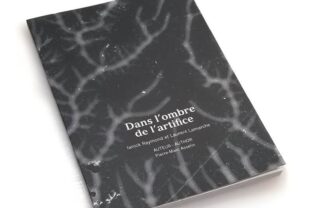Lawrence Paul Yuxweluptun
It is their Time

Lawrence Paul Yuxweluptun’s exhibition Unceded Territories is striking and contemporary. Exceptional, outstanding and impressive, the works draw notice. They are conspicuous. And like the secondary definition of “striking” in the dictionary, the exhibition is “on strike”, a visual protest against a biased interpretation of Indigenous knowledge and history. Unceded Territories is contemporary because it is “existing, occurring or living at the same time.” Yuxweluptun tells the story as it stands today, a story of his people.
The AGO has just appointed Wanda Nanibush as the first curator of Canadian and Indigenous Art. She is Anishinabe from the Beausoleil First Nation, an image and word warrior. She states, “The paintbrush is mightier than the sword.”
Lawrence Paul Yuxweluptun is of Coast Salish and Okanagan descent. He says, “My time is now.”
The exhibition, curated by Tania Willard, Secwepemc, and Karen Duffek, is hosted on the land of his people, and Yuxweluptun states, “I have never surrendered this to you. I will never give this land up to you any of Canadians or your queen.” There is no room for discussion. The land will not be formally resigned. Yuxweluptun will not yield and furthermore, he will remind us with each work that he makes of the injustices planted upon his people.
Lawrence Paul Yuxweluptun acknowledges colonialism and the troubles it perpetuated for Indigenous people by illuminating his perspective: “All of these things that I talk about come from the past. I’ve had to go into the past to talk about the future because when you’re so busy being oppressed, you have very little time to deal with your own history.” This is a contemporaneous statement, simultaneous to a current state of affairs.
Wanda Nanibush posited that for many colonialists an Indigenous voice appears “only authentic in the past.” Yuxweluptun is sharp, clear and with a full palette as he states articulately today with grounded confidence that there has been a serious imbalance. This inequity is currently being addressed with over 60 pieces that show without compromise what Yuxweluptun has created over 30 years – intense visual information that cannot be ignored for the content is as essential as religiosity was to Renaissance masterpieces of old. The first and over-riding impression with Yuxweluptun’s work is that of being in the presence of a work of art and he has brandished an effective sword. The size (183 x 274 cm), execution and composition of works such as Killer Whale Has a Vision and Comes to Talk to Me about Proximological Encroachments of Civilizations in the Oceans are as impressive as those commissioned by an advantaged, biased aristocracy in the Renaissance but this message is current, pressing and un- patronized. Yuxweluptun is not “in the pay” as were the Masters of old but free and firm in expressing his ideas of social structures. With a pop lexicon at play, he has developed a very specific vocabulary to translate an Indigenous perspective for our edification and with modern tropes deployed, his imagery has great graphic impact.
The use of signs, symbols and repetitive forms is often used in traditional Indigenous works. Yuxweluptun has extracted essential forms from northern Northwest Coast art, claiming an ancestral right as in his isolation of the shape which he has elaborated upon in his coinage of the word “ovoidism”. An ovoid is the form that is close to an oval but with a flattened side as can be seen in Yellow Ovoid or Urban Rez.
The visualization of justified grievances can give rise to a sense of guilt for descendants of the colonial oppressors but these paintings are more generous than didactic, opening up positive channels for conversations. Yuxweluptun’s works are lush and like stories loved by children they are told with sensitivity despite the recurring scenes where the wicked witches of a peppered colonial past have reigned – frightening, maleficent and bullying. His rich colors and exacting technique weave times past into our present and Yuxweluptun gives back. He introduces traditional characters that cross between the animal and human or nature and socialization as he passes on the wisdom of a people to whom society is currently turning for guidance on issues concerning the environment, the justice system and community – a reference precipitously overdue. A great act of generosity on Yuxweluptun’s part, the exhibition is a ‘gift’ with intention to welcome and to, perhaps, forgive.
But not to cede.
Lawrence Paul Yuxweluptun: Unceded Territories
Curators: Tania Willard, Secwepemc, Karen Duffek
University of British Columbia Museum of Anthropology
May 10 – October 16, 2016






